Readings Newsletter
Become a Readings Member to make your shopping experience even easier.
Sign in or sign up for free!
You’re not far away from qualifying for FREE standard shipping within Australia
You’ve qualified for FREE standard shipping within Australia
The cart is loading…






Anaerobic/aerobic (AnA) and completely aerobic (CA) laboratory-scale sequencing batch reactors operating on an acetate- and casamino acids-based synthetic wastewater were used to investigate the suitability of the AnA process for treating nutrient-deficient wastewaters in plants that have stringent effluent nutrient requirements. Of particular interest is the case where phosphorus (P)-deficient wastewaters with highly variable influent COD loading are being treated to meet both effluent TSS and P limits. At a 4 d mean cell residence time, AnA activated sludge had an approx. 20 per cent lower P requirement than CA activated sludge. The difference between the end-of-aerobic cycle polyhydroxyalkanoate and carbohydrate contents of the sludges indicated that the AnAsludge used more influent carbon than the CA sludge for synthesis of non-P-containing storage products. The nitrogen requirements of AnA sludge were similar to those of the CA sludge. The AnA and CA SBRs were subjected to three different transient influent COD loading patterns that simulated (No.1) daily COD Loading fluctuations, (No.2) low weekend COD loading, and (No.3) extended low COD loading periods. During the Loading Pattern No.1 experiment, the average effluent soluble P concentrations for the AnA and CA SBRs were 0.4 and 1.0 mgP/L respectively, and complete removal of influent acetate was observed. During the Loading Pattern No.2 experiment, the average effluent soluble P concentrations for the AnA and CA SBRs were 0.3 and 0.9 mgP/L respectively, but effluent acetate was detected during the first high COD loading cycle following the low weekend COD loading period. During the Loading Pattern No.3 experiment, the VSS content of both reactors dropped sharply, effluent acetate breakthrough occurred, and effluent P concentrations exceeding 1 mgP/L were detected in both the AnA and CA SBRs.
$9.00 standard shipping within Australia
FREE standard shipping within Australia for orders over $100.00
Express & International shipping calculated at checkout
Anaerobic/aerobic (AnA) and completely aerobic (CA) laboratory-scale sequencing batch reactors operating on an acetate- and casamino acids-based synthetic wastewater were used to investigate the suitability of the AnA process for treating nutrient-deficient wastewaters in plants that have stringent effluent nutrient requirements. Of particular interest is the case where phosphorus (P)-deficient wastewaters with highly variable influent COD loading are being treated to meet both effluent TSS and P limits. At a 4 d mean cell residence time, AnA activated sludge had an approx. 20 per cent lower P requirement than CA activated sludge. The difference between the end-of-aerobic cycle polyhydroxyalkanoate and carbohydrate contents of the sludges indicated that the AnAsludge used more influent carbon than the CA sludge for synthesis of non-P-containing storage products. The nitrogen requirements of AnA sludge were similar to those of the CA sludge. The AnA and CA SBRs were subjected to three different transient influent COD loading patterns that simulated (No.1) daily COD Loading fluctuations, (No.2) low weekend COD loading, and (No.3) extended low COD loading periods. During the Loading Pattern No.1 experiment, the average effluent soluble P concentrations for the AnA and CA SBRs were 0.4 and 1.0 mgP/L respectively, and complete removal of influent acetate was observed. During the Loading Pattern No.2 experiment, the average effluent soluble P concentrations for the AnA and CA SBRs were 0.3 and 0.9 mgP/L respectively, but effluent acetate was detected during the first high COD loading cycle following the low weekend COD loading period. During the Loading Pattern No.3 experiment, the VSS content of both reactors dropped sharply, effluent acetate breakthrough occurred, and effluent P concentrations exceeding 1 mgP/L were detected in both the AnA and CA SBRs.